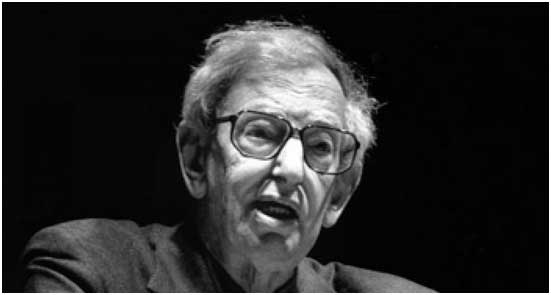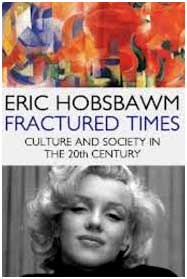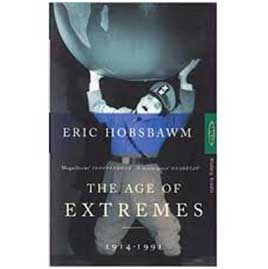Hobsbawms’s posthumous collection of essays, ‘Fractured Times- Culture and Society in the Twentieth Century’(2013), is a tour de force of cultural history

Eric Hobsbawm ( 9 June, 1917 – 1 October, 2012)
In the preface to Fractured Times he wrote just days before his death, Eric Hobsbawm put his future reader on notice that it was going to be “a book about an era of history that has lost its bearings”. This era, he went on to add,
(I)n the early years of the new millennium looks forward with more troubled perplexity than I recall in a long lifetime, guideless and maples, to an unrecognisable future.
Eric Hobsbawm had lived through some of the most cataclysmic episodes in human history: the Great Depression; the Second World War; the Holocaust; the numbing Cold War years; the imploding of the Soviet Union. He had very early lost both his parents, had to leave the pretty Vienna of his childhood for Berlin, a city he came to deeply love but could no longer call his home once Hitler became the German Chancellor – for Eric was a Jew, and a young communist to boot. He and his sister were obliged to migrate to London, but
(s)piritually, I still lived in Berlin: a newly isolated teenager uprooted from an environment in which he had felt happy and at home, both culturally and politically.
Given this chequered personal history, Hobsbawm’s confession of ‘troubled perplexity’ as he surveyed culture and society at the turn of the millennium, has intrigued some critics. They incline to the view that the collapse of institutional communism in the 1990s had so dispirited this ‘unrepentant communist’ that he was taking an inordinately dim view of things. But, in thinking thus, they miss the point that, unlike themselves, the man who wrote Fractured Times (FT) belonged to a generation that stood in a direct line of descent from the European Enlightenment and, in writing these essays, he was looking at what he thought were the ruins of that great tradition. His long, astonishingly full life spanned practically the entire 20th century, and this, along with his cosmopolitan upbringing and his deep and sustained engagement with the politics and culture of many different geographies (including the USA, Africa and Latin America), marked him out from most continental historians who were his younger contemporaries. So, FT is not only a dirge for a vanishing epoch: its writer is chronicling (no doubt with a twinge in his heart) the disappearance of that powerful cargo of beliefs and civilisational values that had quickened and nourished the whole gamut of modern European culture over the 18th and 19th centuries. The falling away of the hope of world revolution – a hope to which Hobsbawm’s generation of Marxists was, in his own words, “tied by an almost unbreakable umbilical chord” – was no doubt a numbing experience, and it is silly to expect that it would not leave its mark on Hobsbawm’s work. But he was too astute a historian, too clear-eyed an intellectual, to let that experience run away with his critique. He is dealing here with “one aspect of the …seismic change humanity has been living through” since 1914 and into the early 21st century, and he is dealing with it the way he does everything else – with verve and passion, also with dazzling insight, but completely unsentimentally.

FT comprises twenty-one essays divided into four segments (titled, variously, The Predicament of ‘High Culture’ Today; The Culture of the Bourgeois World; Uncertainties, Science, Religion: and From Art to Myth) and a stand-alone piece headed Manifestos. The essays evolved out of lectures delivered by the historian at the annual Salzburg Festival between 1964 and 2012 (the year he died), but many are extensively revised, updated and expanded versions of those talks. The subjects range from art nouveau, heritage, and the future of the arts through ‘public religion’, the Jews in Germany and ‘mitteleuropean destinies’, to Karl Kraus, Joseph Needham, and the cultural institution created around the American Cowboy. The common thread that runs through these essays is how “bourgeois fin de siècle culture was forcefully confronted (after the Great War) by myriad new movements and ideologies, from communism and extreme nationalism to Dadaism to the emergence of information technology”.The shortest of the pieces is of 7 pages, the longest, 20, with most essays taking up about 15 double-spaced printed pages. The longer pieces make their respective cases persuasively and at length – aided, no doubt, by Hobsbawm’s incredibly sure grasp of facts and his breathtakingly wide scholarship – while the shorter, more impressionistic, pieces hit home with wit and candour. Manifestos gently chaffs sundry mission- and- vision statements of artistic intent, taking in the Dadaists, the Situationists, Yves Klein, the Futurists and many others who shone brightly, though briefly, on art’s firmament. (He does not forget the Communist Manifesto, either, talking about ‘its soaring analytical vision of world change’, but also reminding the reader that the Manifesto’s clarion call to the workers of the world to unite ‘is…. well past its sell-by date.)
A sense of the evanescent permeates much of the book. Hobsbawm recalls the Vienna of his growing-up years, dominated as it was by the great ring of mid-nineteenth-century public buildings: the monumental City Hall, the classical Parliament, the titanic art history and natural history museums, the university; and, of course, the Grand Opera – places where people of cultivated tastes ‘worshipped at the altars of culture and art’. He remembers the ‘middle Europe’ of his early youth which, politically and culturally now ‘belongs to a past that is not likely to return’, because since Weimar, ‘German culture no longer sets the tone in middle Europe’, and Goethe and Lessing, Holderlin and Heine are no more the building blocks of a continental European education. With tender irony, he draws the portrait of Habsburg Austria in its twilight years, a big, bumbling, once-mighty empire now staggering dangerously, although nonchalantly, towards disaster and disintegration. That portrait provides the backdrop for a memorable recounting of the life and work of Karl Kraus whose bitterly satirical play The Last Days of Mankind managed to find “words for the unsayable at a time when it had not quite yet become unsayable”. Hobsbawm reminds us how even the brilliant Karl Kraus, never at a loss for words, felt his semantic resources running dry when it came to describing National Socialism:”On the subject of Hitler, nothing occurs to me.” And again: “The Word fell asleep when that world awoke.”
In Where are the Arts Going? and elsewhere, Hobsbawm flags the existential crisis facing some art forms, notably classical music and the opera. “Classical music”, he pithily observes, “basically lives on a dead repertoire”. The basic stock of classical music – on which all the world’s great philharmonic and other orchestras expend their considerable interpretative talents — that attracts the broad public consists of no more than between one hundred and two hundred pieces, covering the past two and a half centuries. And the potential concert audience which, even in a city as large as New York comprises no more perhaps than twenty thousand elderly ladies and gentlemen, is hardly replenishing itself. The opera which used to play to rapturous assemblies of the sophisticate all over Europe and the Americas in the 19th and early 20th centuries, finds itself in even direr straits. Indeed, none of the operas in the regular repertoire of well-known producers is much younger than one hundred years old and ‘virtually none was written by a composer born after 1914’. Hobsbawm goes on to add, wryly, that
(n)obody lives by writing operas any more, as people did in the 19th century, and as professional playwrights still do. Overwhelmingly, operatic productions, like Shakespearean play productions, consist of attempts to freshen up eminent graves by putting different sets of flowers on them.
He remarks on ‘a certain exhaustion’ in even the usually dynamic and creative world of commercial mass music, and cites a survey, commissioned in July, 1998, of rock-music fans and experts which showed that nearly all the one hundred ‘best rock records of all time’ came from the 1960s, with virtually none from the 1980s or later. As for the visual arts, things looked hardly more inspiring. In painting in significant measure, lively creative imagination has been giving way to inward-looking contemplation and deliberation, to things like ‘Conceptual’ art a la Marcel Duchamp, whose “ground-breaking exhibition of a public urinal as ‘ready-made art’ …(aimed not to) extend the field of fine art, but to destroy it”. As for sculpture,
(It) is scraping a miserable existence at the edge of culture, for it has been abandoned in the course of this (the 20th) century by both public and private life as a means of recording reality or human-shaped symbolism.
The literary arts, by contrast, are holding up in large measure, though the advent of the internet and the digital has the effect of often turning publishers’ business models upside down. Besides, certain kinds of printed books – encyclopaedias, dictionaries and the great reference books – are steadily, and inevitably, yielding ground to electronic resources.

What has been steadily undermining the traditional social architecture of the arts is the issue of how they are to be funded. From the time when royal or aristocratic (also sometimes ecclesiastical) patronage supported them almost exclusively, the arts have now had to fall back nearly fully on politics (or political power) and the market, ‘the two players in the game of culture’, in Hobsbawm’s words. “They decide how cultural goods and services are to be financed—essentially by the market, or by subsidy”. Now
… the market in principle decides only what makes or fails to make money, not what ought to or ought not to sell…..From the point of view of the market, the only interesting culture is the product or service that makes money…… (And) in the cultural fields the contemporary concept of ‘the market’ – an undiscriminating, globalising search for maximum profit – is quite novel. Until a few decades ago the arts, even for those who made profits from them as investors or entrepreneurs, were not like other products.
But today, they are like any other product in the globalised free market: art dealing or book publishing is no longer essentially different from say, the hardware business, or that of selling women’s lingerie. So, public subsidy to the arts – and this is where politics comes in – is an important funding source, indeed in most countries far more important than private subsidy of the kind offered by charities and non-profits, whose corpuses, even when they are bountiful, are necessarily widely distributed. And it is the abrupt turning off of the public subsidy tap that so seriously threatened most fine arts institutions in East Europe and the former Soviet Union in the immediate aftermath of the dismantling of the socialist block. Prosperous states of Western Europe, on the other hand, have the wherewithal to generously subsidise culture; but, increasingly, demands from other sectors, and the urge to cut taxes to please the super-rich, are coming in the way of states’ munificence, though Hobsbawm thought – mistakenly, as it turns out – that the British government was unlikely to tighten its purse-strings when it came to such subsidies.
In the book’s three brilliant essays on Jewish life in central Europe in the 19th and early 20th centuries, it is hard to miss a faint but discernibly distinct sense of nostalgia. They are amazingly rich in information, but also in historical flavour, as witness the closing lines of The Jews in Germany:
(I)n one respect their (the Jews’) disappearance (by exodus or death) clearly had a dramatic effect. From 1900 to 1933 almost 40 per cent of all Nobel prizes in physics and chemistry went to Germany; since 1933 this has become only one in ten. History records, with tragic irony or black humour, that one of the refugee Nobel laureates insisted on revisiting Germany after 1945, because of his ‘inexhaustible homesickness for the German language and landscape.
Hobsbam’s tribute to the polymath scientist/historian of science/peace activist/communist intellectual J D Bernal is appropriately titled Science: Social Function and World Change. It is the most lapidary obituary of the great man whom C P Snow had described as “perhaps the last man of whom it will be said, with meaning, that he knew science”. With remarkable felicity, Hobsbawm captures the spirit of the time that both produced and was enriched by Bernal. Admiration, and even awe, leap from the lines, but throughout it remains a tightly-fashioned work of narrative prose.
Indeed, in the end FT’s enduring appeal lies in its splendid readability. The enormous fertility of Hobsbawm’s historical imagination is matched by the extraordinary wit, grace and power of his writing. The most celebrated historian of the 20th century was also one of its most outstanding prose writers, and this posthumous collection of essays is a testimony to his virtuosity.
Anjan Basu is a literary critic, commentator and translator. He can be reached at [email protected]









































